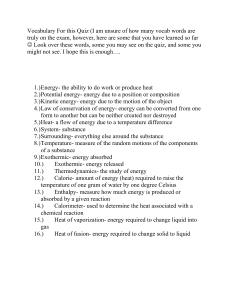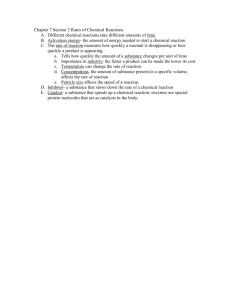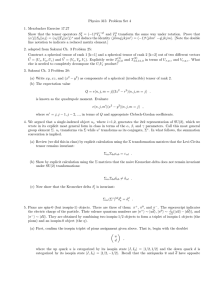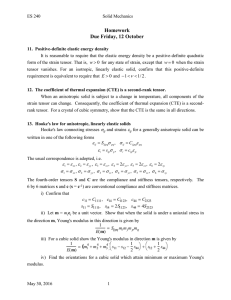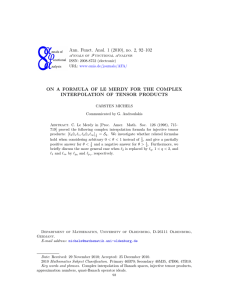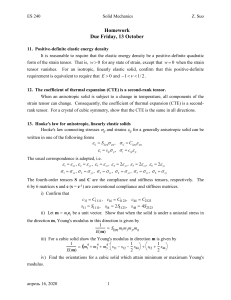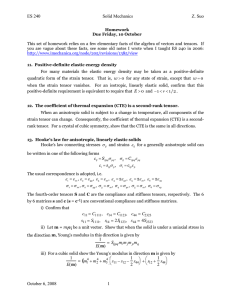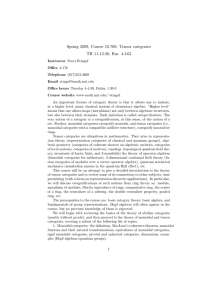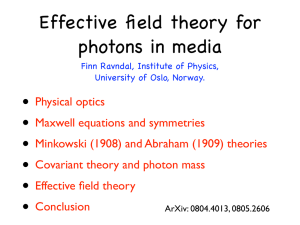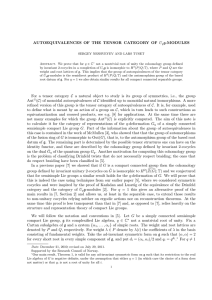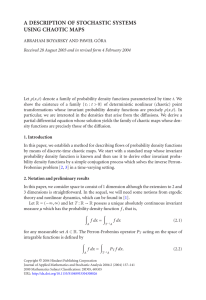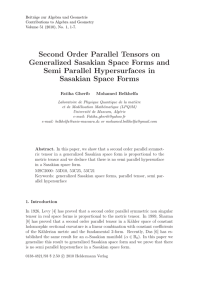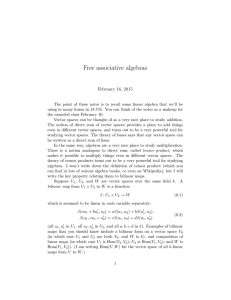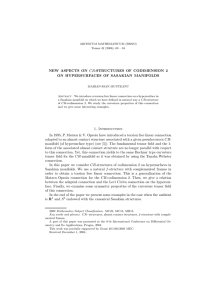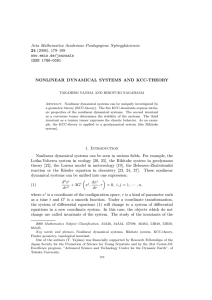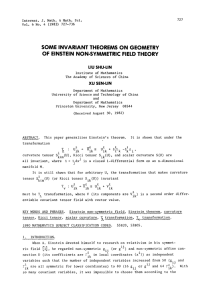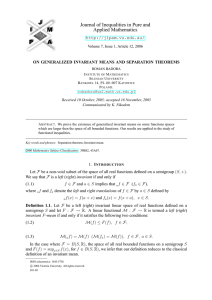! ! ! !! ! !!
advertisement
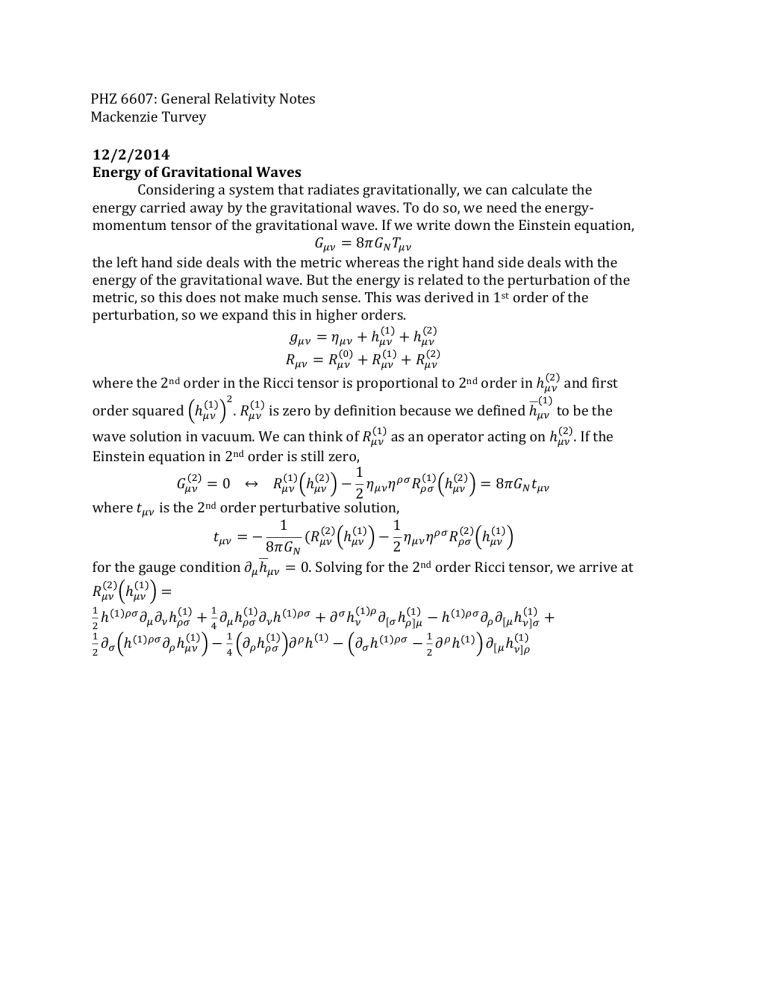
! ! ! ! !! ! !! !!! ! !!" ! !!! !!! !!! ! ! ! !!" !!!!!!! ! ! ! ! ! ! ! ! ! ! ! ! !!! !!! !! ;349!%:'$1!2)!0,*!7)+'*)!%24!*)2!%)*$43$!,*7!23'%)!%:)!9)%3'0!'*!%)39$!4+!! ! !,*7!!! 1! ! Notes PHZ 6607: R!elativity !! G!eneral ! !"#!$%! !! !! !"#$% !!!!!" ! !!!! !!! ! !!!! !!! ! ! ! !"#$% ! Mackenzie Turvey ! !"#"#"$!%& '()*+,&-.&/*0123032-(04&501)6& ! <4*$'7)3'*=!,!$>$%)9!%:,%!3,7',%)$!=3,5'%,%'4*,&&>1!2)!0,*!0,&0#&,%)!%:)! )*)3=>!0,33')7!,2,>!6>!%:)!=3,5'%,%'4*,&!2,5)$?!@4!74!$41!2)!*))7!%:)!)*)3=>. 949)*%#9!%)*$43!4+!%:)!=3,5'%,%'4*,&!2,5)?!A+!2)!23'%)!742*!%:)!B'*$%)'*!)C#,%'4*1! !!" ! !!!! !!" ! %:)!&)+%!:,*7!$'7)!7),&$!2'%:!%:)!9)%3'0!2:)3),$!%:)!3'=:%!:,*7!$'7)!7),&$!2'%:!%:)! )*)3=>!4+!%:)!=3,5'%,%'4*,&!2,5)?!D#%!%:)!)*)3=>!'$!3)&,%)7!%4!%:)!/)3%#36,%'4*!4+!%:)! 9)%3'01!$4!%:'$!74)$!*4%!9,()!9#0:!$)*$)?!@:'$!2,$!7)3'5)7!'*!E$%!437)3!4+!%:)! /)3%#36,%'4*1!$4!2)!)F/,*7!%:'$!'*!:'=:)3!437)3$?! ! ! !!" ! !!" ! !!" ! !!" ! !! ! !!" ! !!"! ! !!"! ! !!"! ! ! 2:)3)!%:)!G*7!437)3!'*!%:)!H'00'!%)*$43!'$!/34/43%'4*,&!%4!G*7!437)3!'*!!!" !,*7!+'3$%! ! 437)3!$C#,3)7! !!" ! ! ?!!!"! !'$!I)34!6>!7)+'*'%'4*!6)0,#$)!2)!7)+'*)7!!!" !%4!6)!%:)! ! ! 2,5)!$4&#%'4*!'*!5,0##9?!8)!0,*!%:'*(!4+!!!" !,$!,*!4/)3,%43!,0%'*=!4*!!!" ?!A+!%:)! B'*$%)'*!)C#,%'4*!'*!G*7!437)3!'$!$%'&&!I)341! ! ! ! ! ! ! !!" ! !!!! ! !!! !!" !!" ! !!" !!" !!" !!" ! !!!! !!" ! ! 2:)3)!!!" !'$!%:)!G*7!437)3!/)3%#36,%'5)!$4&#%'4*1! ! ! ! ! ! !!" ! ! !!!"! !!" ! !!" !!" !!" !!" ! !!!! ! +43!%:)!=,#=)!04*7'%'4*!!! !!" ! !?!J4&5'*=!+43!%:)!G*7!437)3!H'00'!%)*$431!2)!,33'5)!,%! ! !!"! !!" ! ! ! ! ! !" ! ! ! ! ! ! ! ! !! !! !!" ! !! !!" !! ! ! !" ! ! !! !!" ! ! ! ! ! !" !! !!" !! ! ! ! ! ! ! !! ! ! !!! !!!! !! ! !! ! ! !" ! ! !" ! !! ! ! ! ! !! !!! !!!! ! ! !!! !!!! !! for 𝜕! 𝑡!" = 0. But one notices that this is not gauge invariant. We can correct this by going back and noticing that if we average over 3-­‐volume for a few wavelengths over a small enough region, that this becomes gauge invariant (to a low enough order). By small enough, we mean smaller than the curvature of the background, but large enough for a few wavelengths. Only keeping first derivatives, we see, 1 1 ! ! 𝑡!" = 𝜕! ℎ!" 𝜕! ℎ ! !" − 𝜕! ℎ ! 𝜕! ℎ ! − 𝜕! ℎ ! !" 𝜕! ℎ!" 32𝜋𝐺! 2 ! ! !" − 𝜕! ℎ 𝜕! ℎ!" 1 ! !" ! !! 𝜕! ℎ !! 𝜕! ℎ!" = 32𝜋𝐺! This is the energy-­‐momentum tensor (to 2nd order) of the gravitational wave itself. Now that we have this, we can calculate the energy and power radiated away. 𝑃= !! 𝑡!" 𝑛! 𝑟 ! 𝑑Ω where 𝑛! is the normal to the sphere Σ. Relating back to the perturbed metric: 2𝐺 𝑑 ! 𝐼!" 𝑡 − 𝑟 𝜕! 𝜕! ℎ!" = 𝑟 𝑑𝑡 ! the radial differential can be evaluated at 𝑟 = ∞. For the radial-­‐temporal part of the energy-­‐momentum tensor, 𝐺 𝑑 ! 𝐽!" 𝑑 ! 𝐽!" 1 ; 𝐽!" = 𝐼!" − 𝜂!" 𝐼!" 𝜂!" 𝑡!" = − ! ! ! 8𝜋𝑟 𝑑𝑡 𝑑𝑡 2 𝐺 𝑃 = − 𝐽!" 𝐽!" 5 If we consider the gravitational potential of energy radiating out of a sphere, 𝐸 𝐺𝑃 𝐺𝑀 3𝑐 ! ! ~ = < 𝑐 → 𝑃 < 𝐺 𝑐 ! 3𝑐 ! 𝑅 we see that the power radiated is limited, otherwise the system would collapse into a black hole.
